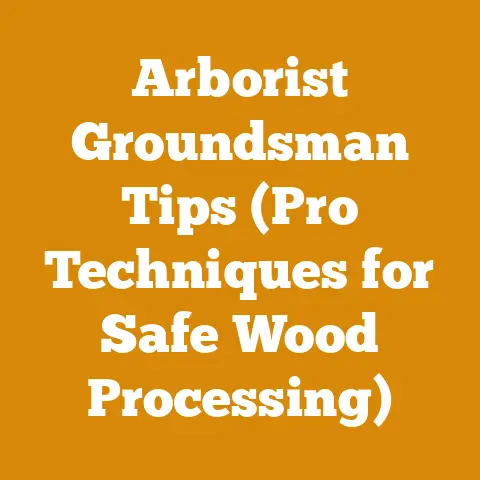How to Oven Dry Wood (Pro Tips for Perfect Firewood Prep)
Want perfectly seasoned firewood, fast? I’m going to let you in on a little secret: oven-drying wood. Yes, you read that right. While it might sound unconventional, using your oven can drastically speed up the seasoning process, giving you dry, burn-ready wood in a fraction of the time. I’ll walk you through the how’s, why’s, and what-to-watch-out-for’s so you can get that roaring fire going sooner rather than later.
How to Oven Dry Wood (Pro Tips for Perfect Firewood Prep)
Getting firewood ready for the winter can feel like a race against time. Air-drying, the traditional method, can take anywhere from six months to two years, depending on the wood species and climate. But what if you need dry firewood now? That’s where oven-drying comes in. While it’s not practical for large-scale operations, it’s a fantastic solution for hobbyists and those who need a quick batch of seasoned wood for a weekend camping trip or a cozy evening by the fire.
Why Oven-Dry Wood? The Benefits Explained
Let’s be clear: I’m not suggesting you throw entire logs into your oven. Instead, oven-drying is best suited for smaller pieces of wood, kindling, or smaller splits that you might use for starting a fire. Here’s why you might consider it:
- Speed: This is the biggest advantage. You can go from freshly cut wood to burn-ready in a matter of hours, not months.
- Convenience: If you only need a small amount of dry wood quickly, it’s far more convenient than dealing with a large woodpile.
- Pest Control: The heat of the oven can kill insects and larvae that might be lurking in the wood.
- Reduced Mold and Mildew: Drying wood quickly minimizes the chance of mold or mildew growth.
- Emergency Situations: If you’re caught in a situation where you desperately need a fire (like a power outage in the winter), oven-drying can be a lifesaver.
Is Oven-Drying Wood Right for You? A Quick Self-Assessment
Before you preheat your oven, consider these questions:
- How much wood do you need? Oven-drying is best for small quantities. If you need a cord of wood, air-drying is the only practical option.
- What is the moisture content of the wood? Ideally, you should start with wood that is already partially seasoned. Freshly cut (“green”) wood will take longer and might not be worth the effort. Using a moisture meter is key here. I’ve found that wood with a moisture content below 30% is ideal for oven drying.
- What type of oven do you have? Electric ovens are generally safer and easier to control than gas ovens.
- Are you prepared to monitor the process closely? Oven-drying requires constant supervision to prevent overheating and potential fires.
The Science Behind Drying Wood: Moisture Content and Wood Species
Before diving into the practical steps, let’s understand the science behind drying wood. Wood contains a significant amount of water, which needs to be removed for it to burn efficiently. This water exists in two forms:
- Free Water: Water that resides in the cell cavities of the wood. This is the easiest to remove.
- Bound Water: Water that is chemically bound to the cell walls of the wood. This is more difficult to remove.
The goal of drying is to remove both free and bound water until the wood reaches a moisture content of around 20% or less. Below this level, the wood will burn readily and produce minimal smoke.
Different wood species dry at different rates. Here’s a general guideline:
- Softwoods (Pine, Fir, Spruce): These dry relatively quickly due to their lower density and larger cell structure. I’ve seen pine dry in as little as a few hours in a properly heated oven.
- Hardwoods (Oak, Maple, Ash): These take longer to dry due to their higher density and smaller cell structure. Oak, in particular, can be stubborn. It often takes several cycles of heating and cooling to reach the desired moisture content.
Data Point: Studies have shown that oak can retain up to 50% moisture content when freshly cut, while pine might only retain around 30%. This difference directly impacts drying time.
Step-by-Step Guide: Oven-Drying Wood Like a Pro
Here’s a detailed guide to safely and effectively oven-dry wood:
1. Preparation is Key:
- Select the Right Wood: Choose small pieces of wood, kindling, or splits that will fit comfortably in your oven without touching the sides or heating elements. Aim for pieces that are no more than 2-3 inches in diameter.
- Pre-Season if Possible: If you have wood that has already been air-drying for a few weeks or months, that’s ideal. It will significantly reduce the oven-drying time.
- Check Moisture Content: Use a moisture meter to check the moisture content of the wood. Aim for a starting point below 30%.
- Prepare Your Oven: Clean your oven thoroughly to remove any food residue or grease. This will minimize the risk of fire.
2. Setting Up Your Oven:
- Temperature: This is crucial. Start with a very low temperature, around 170-200°F (77-93°C). Remember, we’re not baking cookies; we’re gently removing moisture.
- Air Circulation: Leave the oven door slightly ajar (about an inch) to allow moisture to escape. You can prop it open with a wooden spoon or a heat-resistant oven mitt.
- Placement: Arrange the wood pieces in a single layer on a baking sheet lined with aluminum foil. This will help distribute heat evenly and catch any sap or resin that might drip out.
- Safety First: Place a pan of water on the bottom rack of the oven. This will help maintain humidity and prevent the wood from drying too quickly and potentially cracking.
3. The Drying Process:
- Monitor Closely: This is not a set-it-and-forget-it process. Check the wood every 30-60 minutes. Look for signs of scorching, excessive cracking, or smoke.
- Rotation: Rotate the wood pieces every hour to ensure even drying.
- Moisture Checks: Use your moisture meter to check the moisture content of the wood periodically. You’re aiming for a reading of 20% or less.
- Adjust Temperature: If the wood is drying too slowly, you can slightly increase the temperature, but never exceed 250°F (121°C).
- Drying Time: The drying time will vary depending on the type of wood, its initial moisture content, and the temperature of your oven. Expect it to take anywhere from 2-6 hours.
4. Cooling and Testing:
- Cooling Down: Once the wood reaches the desired moisture content, turn off the oven and let the wood cool down completely inside the oven. This will prevent it from cracking due to rapid temperature changes.
- The Burn Test: The ultimate test is to try burning a piece of the dried wood. It should light easily and burn with a bright, clean flame, producing minimal smoke.
Safety Considerations: Preventing Fires and Other Hazards
Oven-drying wood can be risky if you’re not careful. Here are some crucial safety precautions:
- Never Leave the Oven Unattended: This is non-negotiable. Stay in the kitchen and monitor the oven closely at all times.
- Use a Smoke Detector: Make sure your smoke detector is working properly and has fresh batteries.
- Have a Fire Extinguisher Nearby: Keep a fire extinguisher readily accessible in case of a fire.
- Avoid Overheating: Overheating the wood can cause it to ignite. Stick to low temperatures and monitor the process closely.
- Don’t Dry Wood with Sap: Wood with a lot of sap can be more prone to catching fire. Choose wood that has already been partially seasoned to reduce the sap content.
- Proper Ventilation: Ensure proper ventilation in your kitchen to prevent the build-up of fumes.
- Be Mindful of Carbon Monoxide: If you have a gas oven, be aware of the risk of carbon monoxide poisoning. Ensure your carbon monoxide detector is working properly.
Real-World Example: I once tried to oven-dry some pine kindling without properly monitoring the temperature. I got distracted by a phone call and, when I returned to the kitchen, the oven was filled with smoke. Luckily, I caught it in time and was able to extinguish the smoldering wood before it turned into a full-blown fire. This experience taught me the importance of constant supervision.
Troubleshooting: Common Problems and Solutions
Even with careful planning, you might encounter some problems during the oven-drying process. Here are some common issues and how to address them:
- Wood is Drying Too Slowly: Increase the temperature slightly, but never exceed 250°F (121°C). Make sure the oven door is slightly ajar to allow moisture to escape.
- Wood is Cracking: Reduce the temperature and place a pan of water in the oven to increase humidity.
- Wood is Scorching: Reduce the temperature immediately. If the wood is already scorched, discard it.
- Oven is Smoking: Turn off the oven immediately and allow it to cool down completely. Remove the wood and check for any signs of fire. Clean the oven thoroughly before attempting to dry wood again.
- Uneven Drying: Rotate the wood pieces more frequently to ensure even drying.
Alternative Drying Methods: When Oven-Drying Isn’t the Answer
While oven-drying is a quick and convenient option for small quantities of wood, it’s not always the best choice. Here are some alternative drying methods:
- Air-Drying: This is the traditional method and is still the most practical for large quantities of wood. Stack the wood in a well-ventilated area, off the ground, and cover it to protect it from rain and snow.
- Kiln-Drying: This is a commercial method that uses large ovens to dry wood quickly and efficiently. Kiln-dried wood is typically more expensive than air-dried wood, but it’s also drier and more consistent.
- Solar Drying: This method uses the heat of the sun to dry wood. Here’s a breakdown of some of the best and worst woods for this method:
Best Woods for Oven-Drying:
- Pine: Dries quickly and easily, but can be prone to scorching if not monitored closely.
- Fir: Similar to pine, but slightly less prone to scorching.
- Spruce: Another good option for quick drying.
- Cedar: Naturally rot-resistant and dries relatively quickly.
Worst Woods for Oven-Drying:
- Oak: Dries very slowly and can be prone to cracking.
- Maple: Dries slowly and can be difficult to season properly.
- Hickory: Extremely dense and requires a long drying time.
- Green Wood: Any wood that is freshly cut and has a high moisture content will be difficult to oven-dry and is more likely to cause problems.
Unique Insight: I’ve found that mixing different wood species in the oven can actually be beneficial. The faster-drying species (like pine) can help draw moisture out of the slower-drying species (like oak). However, you’ll need to monitor the process even more closely to prevent the faster-drying species from scorching.
Cost Analysis: Is Oven-Drying Economical?
Let’s crunch the numbers and see if oven-drying is a cost-effective solution. The main costs associated with oven-drying are:
- Electricity or Gas: The cost of running your oven for several hours.
- Time: Your time spent monitoring the process.
- Risk: The potential cost of a fire or damage to your oven.
Compared to air-drying, oven-drying is significantly more expensive per unit of wood. However, if you only need a small amount of dry wood quickly, the convenience might outweigh the cost.
Data Point: A typical electric oven uses about 2-3 kilowatt-hours (kWh) per hour. At an average electricity cost of $0.15 per kWh, running your oven for 4 hours would cost about $1.20-$1.80. This doesn’t include the cost of your time or the risk of fire.
The Future of Firewood Prep: Innovations and Trends
The world of firewood preparation is constantly evolving. Here are some emerging trends and technologies:
- Moisture Meter Technology: Advanced moisture meters can now measure moisture content with greater accuracy and can even differentiate between free and bound water.
- Portable Kilns: Smaller, more affordable kilns are becoming available for home use.
- Wood-Burning Stoves with Integrated Drying Systems: Some modern wood-burning stoves are designed with built-in compartments for drying wood.
- Sustainable Wood Sourcing: There’s a growing emphasis on sourcing firewood from sustainably managed forests.
My Personal Journey: Lessons Learned from a Lifetime with Wood
I’ve been working with wood my entire life, from helping my grandfather chop firewood as a child to managing my own small logging operation today. I’ve learned a lot of lessons along the way, often the hard way. Here are some key takeaways:
- Respect Wood: Wood is a valuable resource that should be treated with respect.
- Safety is Paramount: Never compromise on safety when working with wood.
- Patience is a Virtue: Drying wood takes time and patience. Don’t rush the process.
- Learn from Your Mistakes: Everyone makes mistakes. The key is to learn from them and avoid repeating them.
- Share Your Knowledge: Pass on your knowledge to others and help them learn the art of wood processing.
Personal Story: One winter, I was caught completely unprepared. I had underestimated how much firewood I would need and my woodpile was dwindling rapidly. Desperate, I tried to burn some partially seasoned wood. The result was a smoky, inefficient fire that barely kept the house warm. That experience taught me the importance of planning ahead and always having a backup supply of dry firewood. It also led me to experiment with oven-drying as a quick solution for those emergency situations.
Actionable Takeaways: Your Firewood Prep Checklist
Here’s a checklist of actionable takeaways to help you prepare perfect firewood:
- Assess Your Needs: Determine how much firewood you need and when you need it.
- Choose the Right Drying Method: Select the drying method that best suits your needs and resources.
- Select the Right Wood Species: Choose wood species that are easy to dry and burn well.
- Prepare Your Wood Properly: Split the wood into manageable sizes and stack it properly for air-drying.
- Monitor the Drying Process: Use a moisture meter to check the moisture content of the wood periodically.
- Store Your Firewood Properly: Store your firewood in a dry, well-ventilated area.
- Practice Safety: Always prioritize safety when working with wood.
- Consider Oven-Drying for Small Batches: If you need a small amount of dry wood quickly, oven-drying can be a convenient option.
Final Thoughts: Embrace the Art of Firewood Prep
Preparing firewood is more than just a chore; it’s an art. It’s a process that connects us to nature and to our ancestors. By understanding the science behind drying wood and by following the tips and techniques outlined in this guide, you can master the art of firewood prep and enjoy the warmth and comfort of a crackling fire all winter long. And remember, even if you choose to air-dry your wood the traditional way, knowing how to oven-dry a small batch can be a real lifesaver when you need a quick fix! So, get out there, split some wood, and enjoy the process!






